Ways to troubleshoot audio on Windows 10
Windows 10 operating system gives users more advanced features than previous operating systems. However, some machines after installing Windows 10 have some problems, such as the loss of sound . Many people have adjusted the wiring of the audio device to the computer, but the situation has not improved.
If you have checked hardware devices such as speakers, connectors and make sure they have no problems, then the sound loss error may be in the software.
In the following article, we will show you some ways to fix the loss of sound on Windows 10.
Ways to fix Windows 10 computer errors
- Method 1: Check the audio device connector
- Method 2: Fix the connection with Windows Audio Troubleshooter
- Method 3: Adjust the default audio format
- Method 4: Disable audio upgrade process
- Method 5: Install or update audio Drivers
- Method 6: Restart Audio Services
- Method 7: Use Driver Booster's tool to Fix No Sound
- Method 8: Upgrade Windows 10 version
- Method 9: Disable Exclusive Mode
- Method 10: Check the DPC delay
If the computer loses its sound after updating to Windows 10 1809
Many users reflect the characteristics of the computer they are using well, after updating Windows to a newer version like 1809, 1903, it lost sound. If you also suffer from this, try turning off Fast Startup, after not switching off, try more ways below.
Method 1: Check the audio device connector
Before performing a re-check of the installation system on the device, users should check the physical connections, thereby confirming whether the Windows audio loss comes from a hardware or software error. For those who use external speakers, this step should be done first. Check if the connection cord is correct for the connection between the speaker and the computer. Correctly check the Audio and Micro heads to receive audio.
If when plugging in the cord again and still not working, we will check the installation system on Windows 10.
Method 2: Fix the connection with Windows Audio Troubleshooter
The Windows operating system always has the default feature to detect and solve network and audio problems. At the audio icon in the Taskbar , we right- click and select the Troubleshoot sound problems to use the automatic sound scanner on the computer.
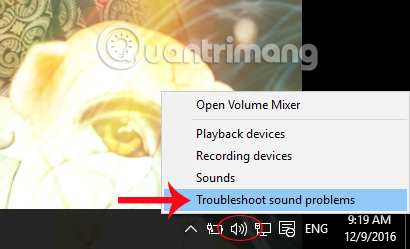
Wait a few minutes for the audio error handler to detect and fix the error automatically. If the error correction process fails, you can also rely on the cause of the sound error to find a way to fix it.
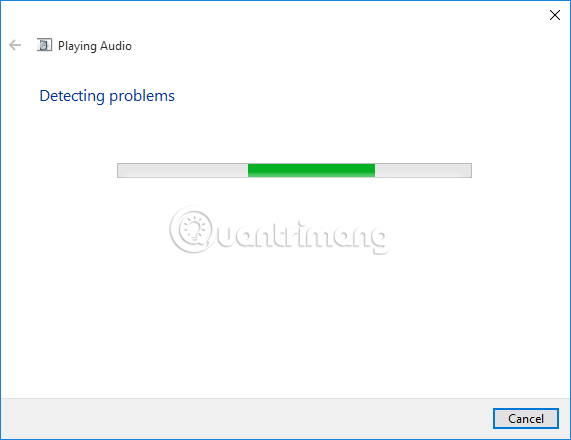
Method 3: Adjust the default audio format
Due to accidentally changing some audio formats on the computer, it also leads to the speakers not making sound.
Step 1:
First of all, also at the audio icon on your computer, right-click and select Playback devices .
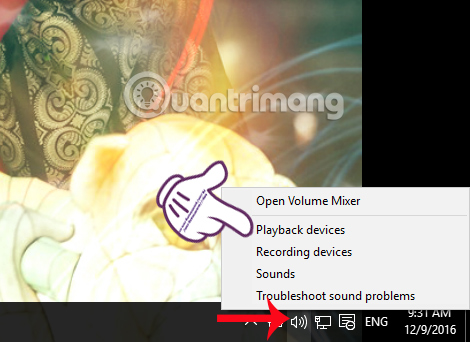
Step 2:
Next to the Sound interface, click on the speaker icon and select Properties .
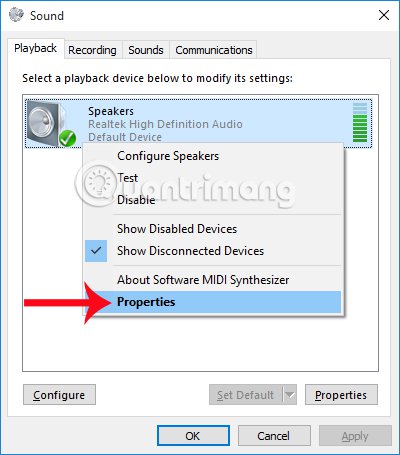
Step 3:
In the Speakers Properties interface, click the Advanced tab . Down below Default Format , we choose 24 bit, 44100 Hz or 24 bit, 192,000 Hz frequency . If not, choose 16 bits, 44100 Hz . Then click OK to save.
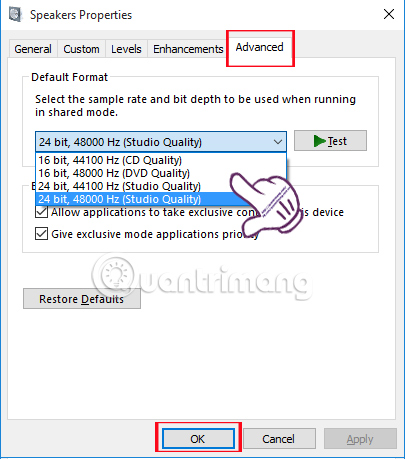
Method 4: Disable audio upgrade process
Audio Enhancements are features available on Windows 10 to improve sound quality with external speaker devices. However, this feature sometimes also causes sound loss.
Step 1:
Also at the audio icon on the screen, right-click and select Playback devices . Then at the audio device interface in use select Properties as steps 1 and 2 in way 3 above.
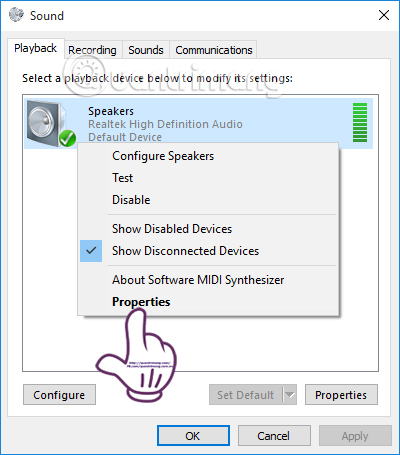
Step 2:
Go to the new interface, click on the Enhancements tab and uncheck it at Disable all enhancements to not use audio enhancements on Windows 10.
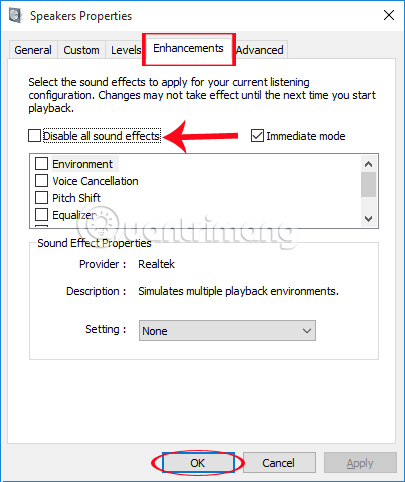
Method 5: Install or update audio Drivers
Usually the sound loss error on the computer comes from the driver error. Maybe drivers are too old and incompatible with the current operating system, causing the computer to lose sound.
Step 1:
We press the Windows + R combination to open the Run dialog box on the computer. Then enter devmgmt.msc keyword , click OK to access.
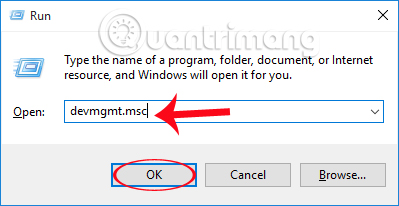
Step 2:
At the new Device Manager interface, double click on Sound, video and game controllers .
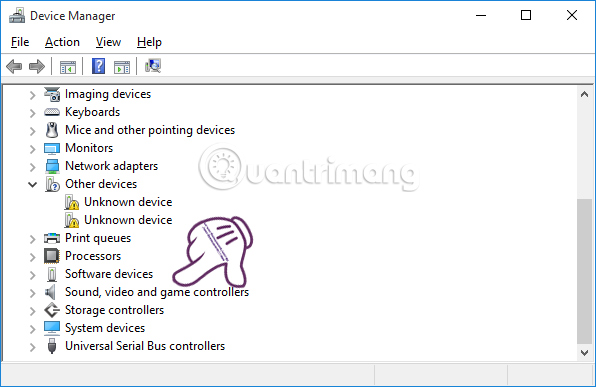
Step 3:
Here we will have 2 ways to update audio drivers, including automatic search and download drivers from the homepage.
First: Download Windows 10 automatic audio drivers
When you double-click on Sound, video and game controllers, an audio driver will appear. We right- click on it and select Update Driver Software .
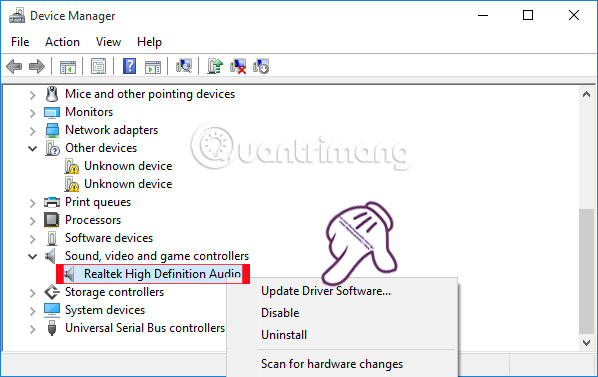
Step 2:
Then, click Search automatically for updated driver software so that Windows will automatically search and update new drivers.
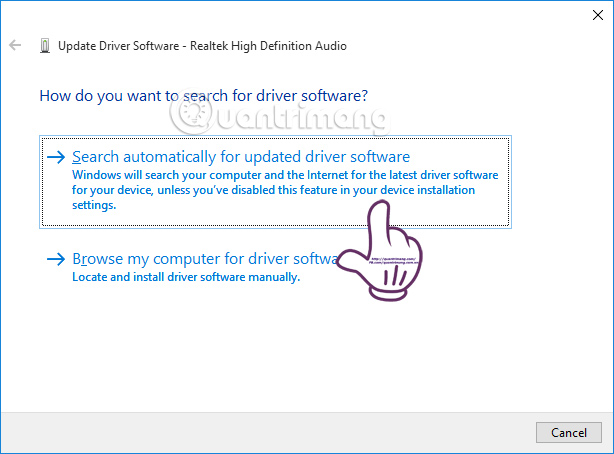
Second: Download the Windows audio driver yourself
Step 1:
If the auto-download driver feature does not work, you can manually find the driver. We proceed to follow step 1 in the above way. But click on Browse my computer for driver software .
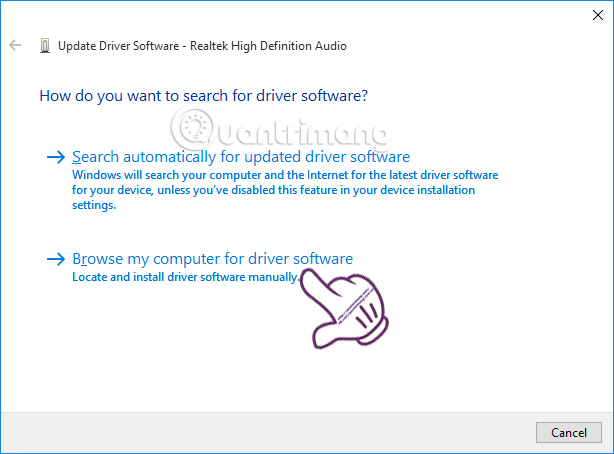
Step 2:
Continue clicking Let me pick from a list of device drivers on my computer , then click Next .
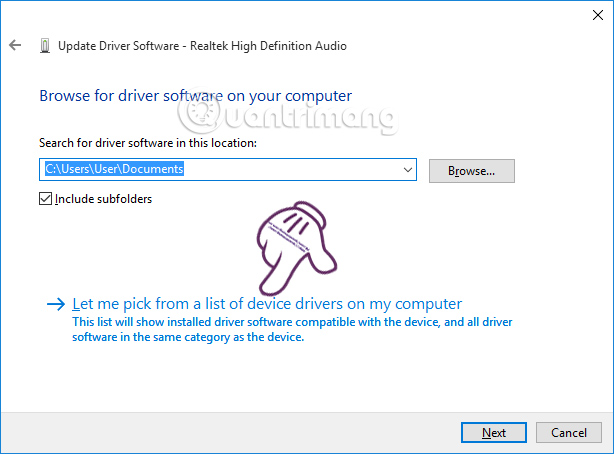
Step 3:
Finally select High Definition Audio Device and click Next to update the new driver.
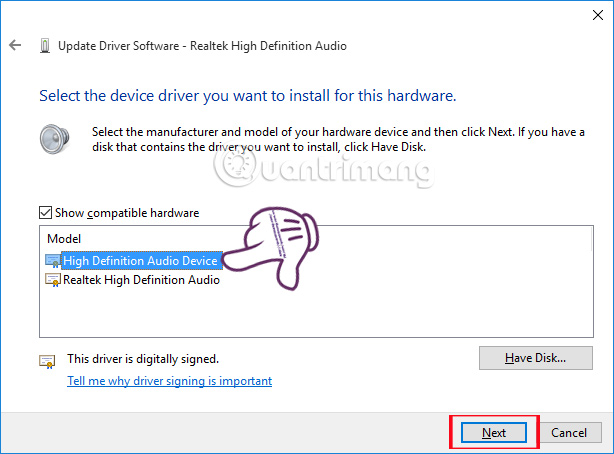
If you are afraid to tinker with system settings to install, update drivers, you can try Driver Booster to update drivers for your computer.
Method 6: Restart Audio Services
Step 1:
Press Windows + R to open the Run dialog box , then type services.msc and click OK .
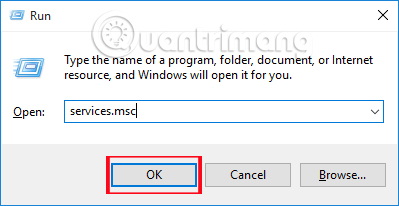
Step 2:
Next, right-click Windows Audio and select Stop to stop Audio Services. Then click Start to restart the service.
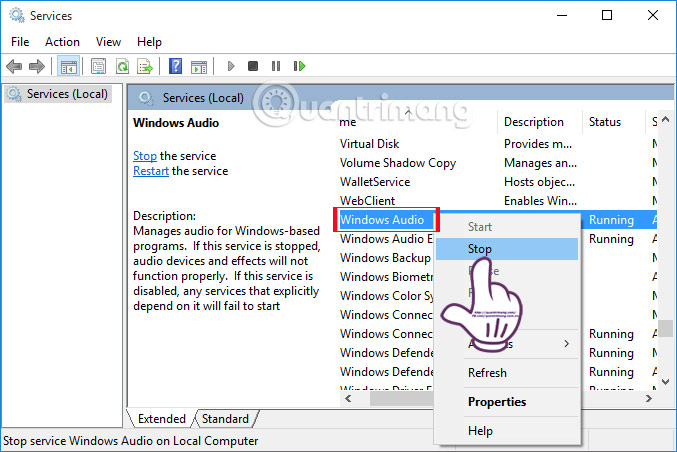
Method 7: Use Driver Booster's tool to Fix No Sound
Software Update Driver Booster has a small tool called Fix No Sound, which helps you fix computer lost sound. You download Driver Booster to install on your computer. Then, click on the tool icon on the left hand side> select Fix No Sound .
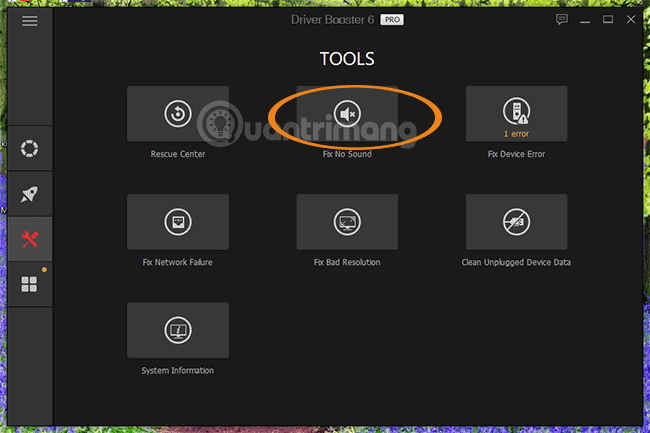
In the small window that appears, select Fix, wait a moment for the tool to check and fix audio loss on your computer.
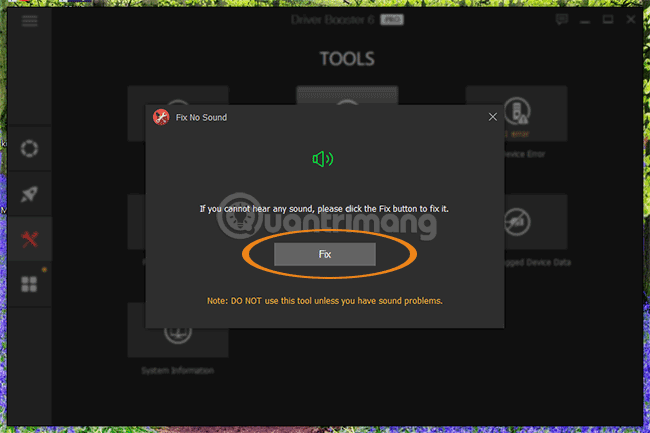
Method 8: Upgrade Windows 10 version
If the version of Windows you are using has problems, you can upgrade to the latest version to fix the audio loss error.
Step 1:
At the Settings interface on Windows 10, we click on the Update & Security button.
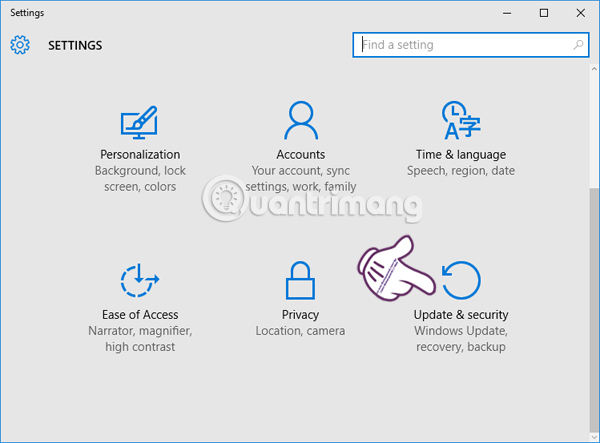
Step 2:
Next, select Windows Update in the left menu bar and select Check for updates on the right for Windows to check and upgrade versions if available.
- Instructions to upgrade to Windows 10 from Windows 7/8 / 8.1
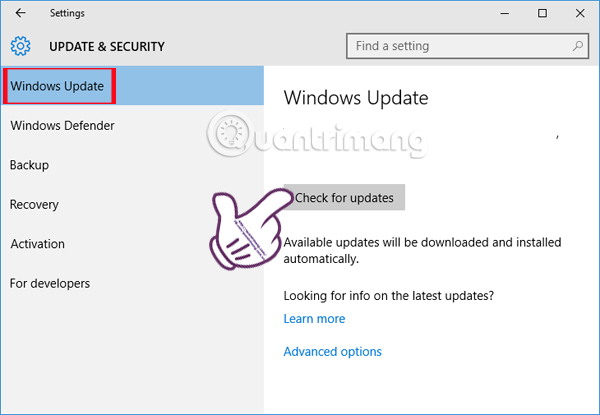
These are some ways to help Windows 10 users to troubleshoot audio loss problems on their computers. If you use external speaker connection, you should first check the connectors, then proceed to adjust the settings we mentioned above.
Method 9: Disable Exclusive Mode
Some audio drivers seem to have problems with the " Exclusive Mode " option, which allows the application to control your sound card exclusive. This is usually not a big problem. It is the bad sound driver that caused the problem on your system.
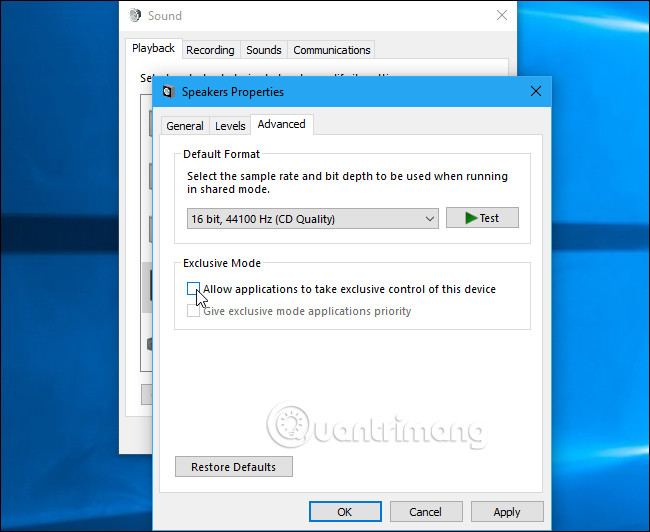
You will find this installation on the same window with the option ' Default Format '. Disable the ' Allow applications to take exclusive control of this device ' option in ' Exclusive Mode '. Click ' OK ' and see if this fixes your problem.
You can re-enable it if disabling this option does not solve the problem.
Method 10: Check the DPC delay
This problem may also be caused by the DPC delay. DPC stands for ' Deferred Procedure Call '. This is part of Windows, handling hardware drivers. If the driver takes too much time to do something, it may prevent other drivers, such as your audio driver can perform the task in a timely manner. This can lead to sound problems such as boiling, hissing and other problems.
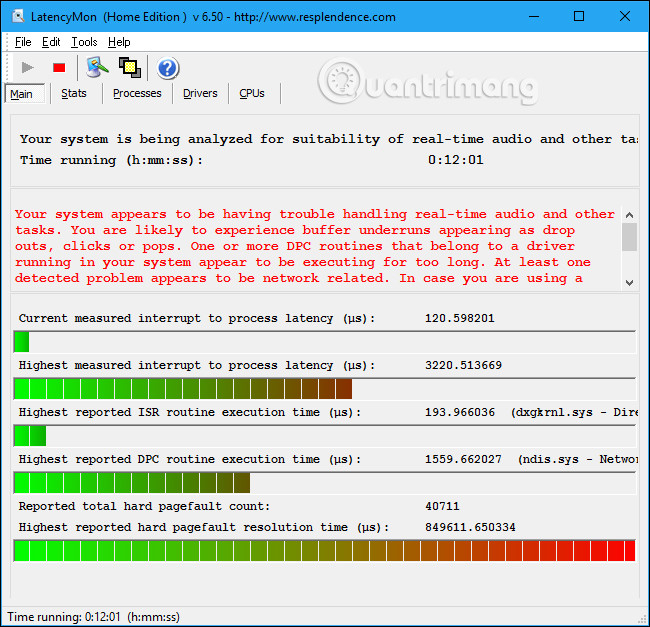
To check your DPC latency, download and run LatencyMon. Click the " Start " button and let it run in the background for some time. It will monitor your system's hardware drivers and provide recommendations, telling you which hardware drivers might be having problems. If a specific hardware driver is causing the problem, you can try to update the device driver, turn off the device, remove the device from your system or replace it.
Even if you see some latency issues here, they won't necessarily become a problem for a regular PC, where you just need to listen to music, watch videos and play video games. If the tool warns you of a problem but you don't see a problem, you don't need to disable any hardware. This is more important for professional use cases where you really need real-time audio. However, if you find something wrong, the tool may indicate a hardware driver with an error.
- Download link LatencyMon: http://www.resplendence.com/latencymon
Refer to the following articles:
- Headphone, earphones are shy, noisy, hard to hear and how to fix them?
- Instructions for checking Microphone, Headphone on Windows 7
I wish you all success!
 Fix 'One or more audio service isn't running' error on Windows 10
Fix 'One or more audio service isn't running' error on Windows 10 Troubleshoot audio loss problems on Mac
Troubleshoot audio loss problems on Mac How to record audio files in Windows 10
How to record audio files in Windows 10 How to troubleshoot OneDrive after resetting on Windows 10
How to troubleshoot OneDrive after resetting on Windows 10 5 easy ways to extract audio from video
5 easy ways to extract audio from video